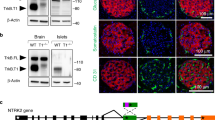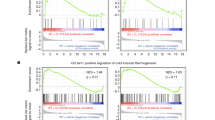Abstract
Leptin, the protein encoded by the obese (ob) gene, is synthesized and released in response to increased energy storage in adipose tissue1,2,3,4. However, it is still not known how incoming energy is sensed and transduced into increased expression of the ob gene. The hexosamine biosynthetic pathway is a cellular ‘sensor’ of energy availability5,6,7,8 and mediates the effects of glucose on the expression of several gene products9,10,11,12. Here we provide evidence for rapid activation of ob gene expression in skeletal muscle by glucosamine. Increased tissue concentrations of the end product of the hexosamine biosynthetic pathway, UDP-N-acetylglucosamine (UDP-GlcNAc), result in rapid and marked increases in leptin messenger RNA and protein levels (although these levels were much lower than those in fat). Plasma leptin levels and leptin mRNA and protein levels in adipose tissue also increase. Most important, stimulation of leptin synthesis is reproduced by either hyperglycaemia or hyperlipidaemia, which also increase tissue levels of UDP-N-acetylglucosamine in conscious rodents7. Finally, incubation of 3T3-L1 pre-adipocytes and L6 myocytes with glucosamine rapidly induces ob gene expression. Our findings are the first evidence of inducible leptin expression in skeletal muscle and unveil an important biochemical link between increased availability of nutrients and leptin expression.
This is a preview of subscription content, access via your institution
Access options
Subscribe to this journal
Receive 51 print issues and online access
$199.00 per year
only $3.90 per issue
Buy this article
- Purchase on Springer Link
- Instant access to full article PDF
Prices may be subject to local taxes which are calculated during checkout




Similar content being viewed by others
References
Zhang, Y. et al. Positional cloning of the mouse obese gene and its human homologue. Nature 372, 425–432 (1994).
Pelleymounter, M. A. et al. Effects of the obese gene product on body weight regulation in ob/ob mice. Science 269, 540–543 (1995).
Halaas, J. L. et al. Weight-reducing effects of the plasma protein encoded by the obese gene. Science 269, 543–546 (1995).
Campfield, L., Smith, F. J., Guisez, Y., Devos, R. & Burn, P. Recombinant mouse OB protein: evidence for a peripheral signal linking adiposity and central neural networks. Science 269, 546–549 (1995).
Marshall, S., Bacote, V. & Traxinger, R. R. Discovery of a metabolic pathway mediating desensitization of the glucose transport system: role of hexosamine biosynthesis in the induction of insulin resistance. J. Biol. Chem. 266, 4706–4712 (1991).
Rossetti, L., Hawkins, M., Chen, W., Gindi, J. & Barzilai, N. In vivo glucosamine infusion induces insulin resistance in normoglycemic but not in hyperglycemic conscious rats. J. Clin. Invest. 96, 132–140 (1995).
Hawkins, M., Barzilai, N., Hu, M., Chen, W. & Rossetti, L. Role of the glucosamine pathway in fat-induced insulin resistance. J. Clin. Invest. 99, 2173–2182 (1997).
Hawkins, M. et al. The tissue concentration of UDP-N-acetylglucosamine modulates the stimulatory effect of insulin on skeletal muscle glucose uptake. J. Biol. Chem. 272, 4889–4895 (1997).
Sayeski, P. P. & Kudlow, J. E. Glucose metabolism to glucosamine is necessary for glucose stimulation of transforming growth factor-a gene transcription. J. Biol. Chem. 271, 15237–15243 (1996).
Daniels, M. C. et al. Glucose regulation of transforming growth factor-alpha expression is mediated by products of the hexosamine biosynthesis pathway. Mol. Endocrinol. 7, 1041–1048 (1993).
McClain, D., Paterson, A., Roos, M., Wei, X. & Kudlow, J. Glucose and glucosamine regulate growth factor gene expression in vascular smooth muscle cells. Proc. Natl Acad. Sci. USA 89, 8150–8154 (1992).
Han, I. & Kudlow, J. E. Reduced O glycosylation of Sp1 is associated with increased proteasome susceptibility. Mol. Cell. Biol. 17, 2550–2558 (1997).
Rossetti, L., Smith, D., Shulman, G. I., Papachristou, D. & DeFronzo, R. A. Correction of hyperglycemia with phlorizin normalizes tissue sensitivity to insulin in diabetic rats. J. Clin. Invest. 79, 1510–1515 (1987).
Hu, E., Liang, P. & Spiegelman, B. AdipoQ is a novel adipose-specific gene dysregulated in obesity. J.Biol. Chem. 271, 10697–10703 (1996).
Gong, D.-W., He, Y., Karas, M. & Reitman, M. Uncoupling protein-3 is a mediator of thermogenesis regulated by thyroid hormone, b3-adrenergic agonists, and leptin. J. Biol. Chem. 272, 24129–24132 (1997).
Schwartz, M. W., Peskind, E., Raskind, M., Boyko, E. J. & Porte, D. J. Cerebrospinal fluid leptin levels: relationship to plasma levels and to adiposity in humans. Nature Med. 2, 589–593 (1996).
Flier, J. S. Leptin expression and action: new experimental paradigms. Proc. Natl Acad. Sci. USA 94, 4242–4245 (1997).
Ahima, R. S. et al. Role of leptin in the neuroendocrine respone to fasting. Nature 382, 250–252 (1996).
Boden, G., Chen, X., Mozzolo, M. & Ryan, I. Effect of fasting on serum leptin in normal human subjects. J. Clin. Endocrinol. Metab. 81, 3419–3423 (1996).
Kolaczynski, J. W. et al. Responses of leptin to short-term fasting and refeeding in humans: a link with ketogenesis but not ketones themselves. Diabetes 45, 1511–1515 (1996).
Saladin, R. et al. Transient increase in obese gene expression after good intake or insulin administration. Nature 377, 527–529 (1995).
Kolaczynski, J. W. et al. Acute and chronic effects of insulin on leptin production in humans: studies in vivo and in vitro. Diabetes 45, 699–701 (1996).
MacDougald, O. A., Hwang, C. S., Fan, H. & Lane, M. D. Regulated expression of the obese gene product (leptin) in white adipose tissue and 3T3-L1 adpocytes. Proc. Natl Acad. Sci. USA 92, 9034–9037 (1995).
Segal, K. R., Landt, M. & Klein, S. Relationship between insulin sensitivity and plasma leptin concentration in lean and obese men. Diabetes 45, 988–991 (1996).
Baron, A. et al. Glucosamine induces insulin resistance in vivo by affecting GLUT4 translocation in skeletal muscle. J. Clin. Invest. 96, 2792–2801 (1995).
Hebert, L. et al. Overexpression of glutamine:fructose-6-phosphate amidotransferase in transgenic mice leads to insulin resistance. J. Clin. Invest. 98, 930–936 (1996).
Robinson, K. A., Sens, D. A. & Buse, M. G. Pre-exposure to glucosamine induces insulin resistance of glucose transport and glycogen synthesis in isolated rat skeletal muscles. Diabetes 42, 1333–1346 (1993).
Wang, J., Hawkins, M. & Rossetti, L. Glutamine:fructose-6-P admidotransferase (GFA) gene expression is induced by glucosamine flux in skeletal muscle. Diabetes 46 (suppl.), 325 (1997).
Muoio, D. M., Dohn, G. L., Fiedorek, F. T., Tapscott, E. B. & Coleman, R. A. Leptin directly alters lipid partitioning in skeletal muscle. Diabetes 46, 1360–1363 (1997).
Acknowledgements
We thank M. Hu and W. Chen for technical assistance. This work was supported by grants from the NIH and the American Diabetes Association and by the Albert Einstein Diabetes Research and Training Center. L.R. is the recipient of a Career Scientist Award from the Irma T. Hirschl Trust and N.B. of the Beeson Physician Faculty Scholar in Aging Award.
Author information
Authors and Affiliations
Corresponding author
Rights and permissions
About this article
Cite this article
Wang, J., Liu, R., Hawkins, M. et al. A nutrient-sensing pathway regulates leptin gene expression in muscle and fat. Nature 393, 684–688 (1998). https://doi.org/10.1038/31474
Received:
Accepted:
Issue Date:
DOI: https://doi.org/10.1038/31474
This article is cited by
-
Fatty Acids and their Proteins in Adipose Tissue Inflammation
Cell Biochemistry and Biophysics (2024)
-
Sex-specific differences in metabolic hormone and adipose tissue dynamics induced by moderate low-carbohydrate and ketogenic diet
Scientific Reports (2023)
-
Leptin signaling in breast cancer and its crosstalk with peroxisome proliferator-activated receptors α and γ
Clinical and Translational Oncology (2022)
-
Recent advances and future avenues in understanding the role of adipose tissue cross talk in mediating skeletal muscle mass and function with ageing
GeroScience (2021)
-
Immunolocalization of leptin and leptin receptor in colorectal mucosa of ulcerative colitis, Crohn’s disease and control subjects with no inflammatory bowel disease
Cell and Tissue Research (2021)
Comments
By submitting a comment you agree to abide by our Terms and Community Guidelines. If you find something abusive or that does not comply with our terms or guidelines please flag it as inappropriate.



